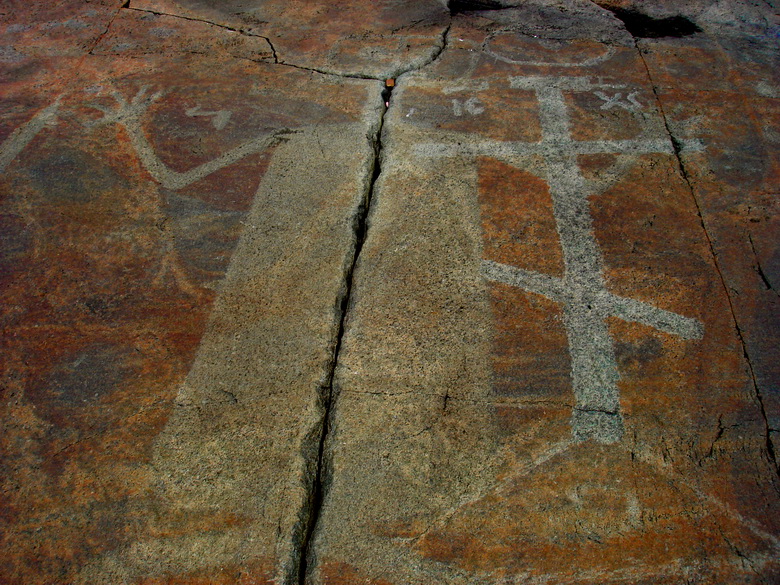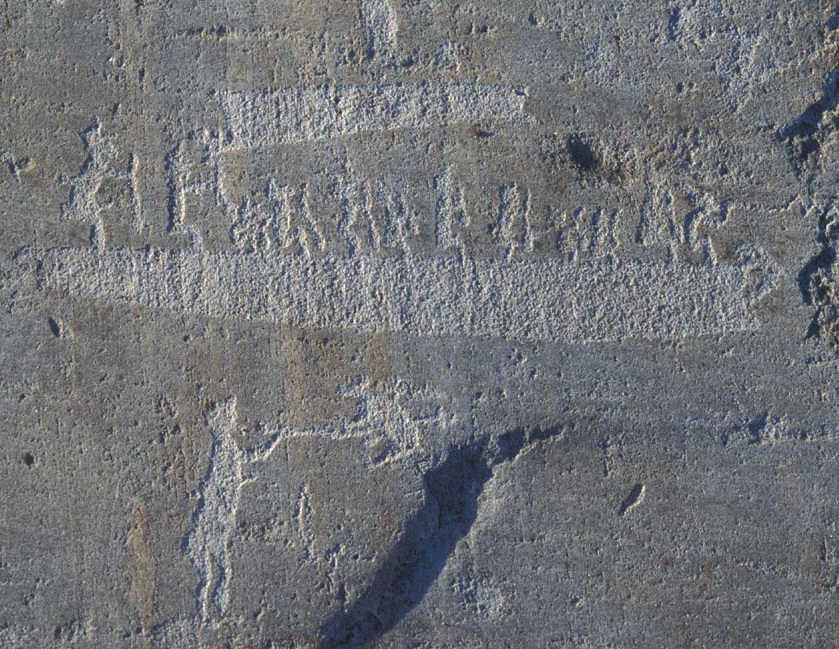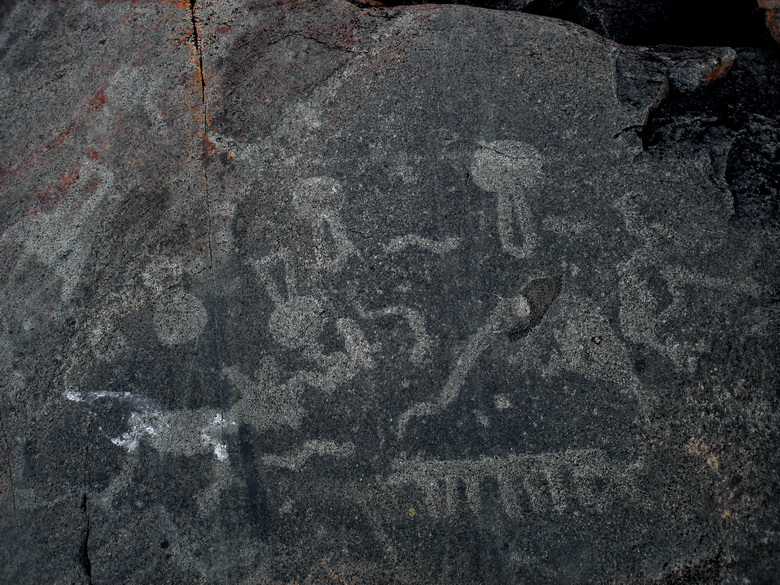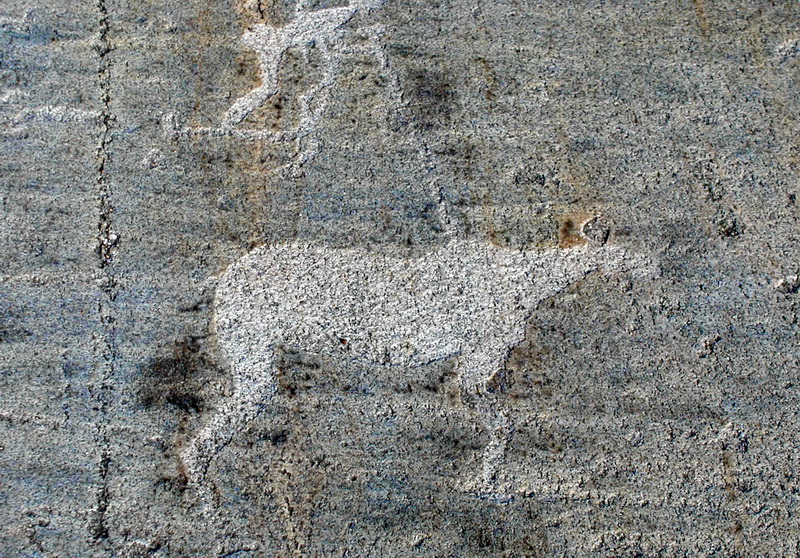Karelian petroglyphs became one of the most popular and outstanding monuments of ancient culture within Northern Europe. Two rock art localities are known: on the eastern shore of Onega Lake (Pudozhsky district) and in the White Sea area in the lower reaches of Vyg River (Belomorsk district).These are the largest assemblages of the carvings in European Russia, they date back to the Neolithic period. About 1200 individual petroglyphs have been found in one case (Onego) and 2500 in the White Sea region. They are considered to be ancient sanctuaries – a kind of special sacred centers of prehistoric communities. Ritual festivals and ceremonies were likely held there, previous experience that people gradually gained about the life and the surrounding world was kept in the figural shape and handed down from generation to generation.
In fact, significance of the White Sea and Onego petroglyphs can hardly be overestimated. It is the most important source of our knowledge about primeval humans, who lived in Northern Europe more than 6,5 thousand years ago and their mythology, and mentality, life style and activities. Rock art galleries of the White Sea and Onego Lake are the real pearls of ancient culture world wide. They indeed, are the archeological “visit card” of Karelia. Not by chance, in majority of publications they are called a “stone book”, “stone chronicles” or “awareness shop”, and considered worthy of being registered in the World Heritage List. Onego carvings are different from others with their metaphoric character, fantastic nature and exotics of images, while White Sea artifacts are of peculiar to realistic origin. Their significant value is a variety of themes and styles, abundance of scenes, availability of multi-figure compositions, including human figures, quality of carving, relatively good condition, exclusively expressive environment, and abundance of ancient sites nearby rock artifacts. Among White Sea petroglyphs there are multi-figure compositions worth relating to masterpieces of world primeval art.
Rock art of Karelia is well known worldwide. They are presented in large scientific publications in Russian, English, German and Finnish, in catalogues, encyclopedias, articles, popular books, and even in fiction books thanks to Linevsky A.V. The story “Stone Book pages”, written by him on materials of petroglyphs for school children gained world acceptance. Nowadays Karelian rock carvings turn to be a destination of frequent international and scientific expeditions. Projects on use of petroglyphs for tourist and educational purposes are being offered. Artifacts are used in fairs, museum exhibitions, leaflets, articles in newspapers and magazines are published.
Today this ancient art becomes more and more popular and valuable resource in cultural tourism, and requires sustainable and wise use and awareness. It is to be remembered that petroglyphs of Karelia are outstanding, but not just on their own, they are the part of the world rock art performed in almost all continents. All Fennoscandia (including Kola Peninsula, wherein have been recently revealed new important samples on the river Umba) is rich with them. Ancient rock art artifacts are more interesting for tourists than other archeological objects; they bear the huge informational potential for modern society. Particular interest of both scientists and travel agencies to Karelian rock art being observed within last few years, seriously makes approach the issues of research, conservation, efficient protection and rational use of unique artifacts. Above said issues require utilization of the scope of serious activities demanding significant efforts both organizational and financial. These activities should base on effective cooperation between specialists of different trends and institutions, guard bodies, scientific institutions, museums, different foundations, and NGOs. Unfortunately it is to be stated that real value of petroglyphs and importance of problems related thereto still not realized in the full scale. There is a plenty of objective and subjective reasons. The most common and may be the most important is an insufficiently deep and strong interest to the heritage of the country and weak historical memory. Another reason is probably the peculiarity of rock carvings. At first blush they are not so impressive because very often they are hardly visible. These artifacts give strong impression before sunset and during sunrise. Specially trained guides are needed to find an access to the carvings. And finally, not everyone is able to come directly to the site, though petroglyphs are relatively accessible for visitors.
Experts consider as the best solution, to establish in Karelia open air museums of primitive culture, and use them for research, conservation and tourist purposes. Other solutions are also to be considered. Probably the eastern shore of the Onego Lake is mostly suitable for establishing a nature park or preserve. It might become the best pilot area for scientific research and limited and strictly regulated tourist destination. Unfortunately the government has paid and still pays little attention to rock art of Karelia. Actually rock carvings are still unattended, and this leads from time to time to damages of petroglyphs by vandals. They make fireplaces; make their own carvings nearby petroglyphs and sometimes over them. Researchers also admit negative natural impacts (ice, water, soil acid, lichens) on rock surface which gradually damage ancient carvings.
Undoubtedly certain attempts to improve the situation with petroglyph protection like projects of protected areas for artifacts, and its environment, approaches to their use etc. have been taken several times, though they are all in vain without properly developed strategy. Imperfectness of legislation, disconnection of governmental bodies responsible for cultural heritage have affected on the situation. Very important role in drawing attention to protection and use of Onego and Belomorsk petroglyphs has been played by different international projects within recent 10 years. These are Karelian-Norwegian project “Conservation of Karelian petroglyphs”(1997-2001), Karelian-British project “Microlandscape and petroglyphs of the White Sea” (2002-2010), micro project TACIS “stone book of the White sea” (2006), started in 2007 the new project with Riksantikvaren (Norway) will focus on continuation and more profound activities on petroglyphs of Karelia. Results of research activities create the platform for management; define preconditions, departure point, and further movement to right direction. Only if taking aforesaid into consideration, and having real support from governmental institutions of all levels, local people, and community, it becomes possible to include rock artifacts as the most valuable objects of our cultural and historic heritage, in the process of revival and culture development.




